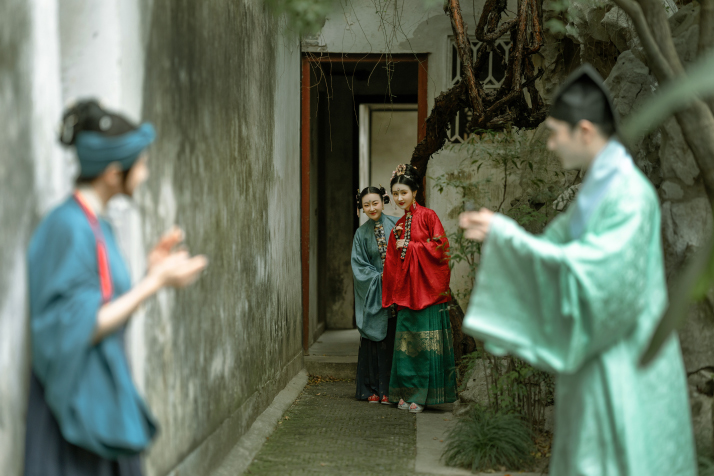| Lifestyle |
| New trends in the protection of Chinese dialects | |
|
|
  Stills from a collaborative video in Suzhounese by Shenlouzhi Studio and iFLYTEK released in March (COURTESY PHOTO)
What was life like in ancient China? If you've ever pondered this question, a studio called Shenlouzhi may give you some insights. Shenlou means "mirage," zhi translates as "recording." "Ancient life is like an illusion for us contemporary people; it appears to be fantastic, but is completely out of reach so we'll never really know what things were really like back in the day. That's how we came up with this name," Wu Yicheng, founder of the studio, told Beijing Review. Established in 2019, the young team of five creates short stories set in different dynasties and regions, and turns them into videos to introduce traditions and cultures from all over China. Each production involves a lot of work, ranging from historical research to creating authentic costumes and tracking down era-appropriate accessories and furniture. Moreover, all stories are told in the dialect of their geographical origin, impressing viewer audiences nationwide. By late June, the studio had released three videos. One of them is in the Suzhou dialect—or Suzhounese. It tells the tale of a Ming Dynasty (1368-1644) chef who had the chance to listen to some Kunqu Opera after she prepared a meal for a hungry opera performer. Gardens, food, and tradition... The video includes many Suzhounese elements, reflecting the city's exquisite lifestyle in ancient China. Another one of its highlights is the use of artificial intelligence (AI) for its voice-over narration, courtesy of the studio's collaboration with leading Chinese AI firm iFLYTEK. "The experience made me reevaluate the relationship between dialects and advanced technologies," Wu said. "Today, I see more options to pass our dialects on to the next generations thanks to scientific and technological developments," the linguaphile from Jingdezhen, Jiangxi Province, added. Finding one's voice Established in 1999, iFLYTEK creates voice recognition software and has 10-plus voice-based Internet/mobile products covering the education, communication, music and smart toys industries in its repertoire. The company's cooperation with Shenlouzhi Studio began in October 2021, with its first production released two months later. "The video documents traditional aesthetics and culture, which can reach more young netizens," Li Qiangjun, the initiator of iFLYTEK's project on dialect protection, said. The project was initiated in 2017. Li believes this latest collaboration with Shenlouzhi Studio can help people better understand Suzhou's culture, including its dialect. Suzhounese is one branch of the Wu language, widely spoken in the Yangtze River Delta. Wu, and the Suzhou dialect, in particular, are perceived as "soft" to the ear, even resulting in a well-known Chinese idiom: the tender speech of Wu. Suzhou dialect is a complex language as different districts and counties speak different forms of Suzhounese, each featuring their own unique pronunciation. This meant that the video's AI voice-over narration required the guidance from dialect coaches to get the most authentic accent and vocabulary possible. iFLYTEK also improved its speech synthesis system. After analyzing large amounts of Suzhounese data, it produced a soundtrack, indexes of which were adjusted according to experts' suggestions in terms of tone, intonation, pausing and breathing, to ensure the storyline unfolded in line with the historical background and personality traits of the characters. Making the most of the latest technologies in speech recognition as well as its influence in the industry, iFLYTEK wanted to create both a database and a platform for communication between dialect speakers and organizations promoting the different dialects of China. It has built an Internet platform and a smartphone application for users who are willing to protect and promote their own dialects to voluntarily upload their speech. Thanks to their participation, 23 dialects have been included in iFLYTEK's project. Preserved for posterity "Dialect protection is a means to inherit our culture and history as both retain the local characteristics," Li said, adding they further strengthen people's sense of identity as well as each city's ability to promote its unique culture. iFLYTEK hopes to create a digital public cultural space integrating the preservation, protection, display, exchange, research and creative development of dialect culture, leading the way in dialect culture popularization and promoting dialect protection. The inheritance of local dialects is a common concern across China as many are on the verge of disappearing. For instance, the China Language Resources Protection Project, launched by the Chinese Government, has been surveying, displaying and developing language resources for seven years. Implemented by the Ministry of Education and the National Language Commission, it is the world's largest language resource base. Zhao Rixin, a professor studying dialects at Beijing Language and Culture University, told Beijing Review that the government project is carried out through field research that records the speech of native dialect speakers nationwide. "The language resources protection project focuses on dialects in their purest forms; in fact, they could all very well be on display at museums as part of the country's culture. However, iFLYTEK's project encourages people to use their native dialects so that they remain living languages," Li said. Chinese e-commerce giant Alibaba, too, has been active in the field of language protection since 2019. Starting from the Sichuanese dialect, the company launched a competition to select outstanding dialect speakers. The winner received an hourly income of 700 yuan ($103.8) to record her voice, which was used in the company's intelligent voice interaction products, like the Tmall Genie. Protecting dialects requires cooperating with society, including companies, organizations and individuals, so we can achieve sustainable development for dialects, Li said. (Printed Edition Title: Sounds of Home) Copyedited by Elsbeth van Paridon Comments to liqing@cicgamericas.com |
|
||||||||||||||||||||||||||||||
|
